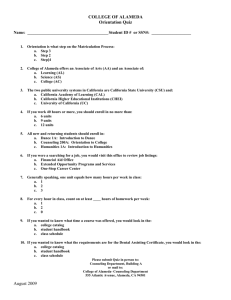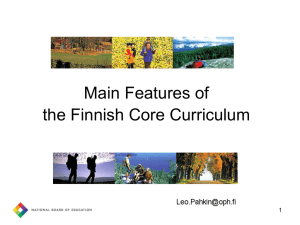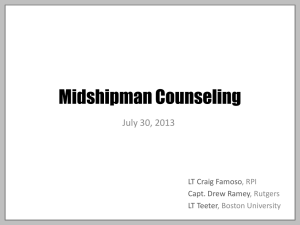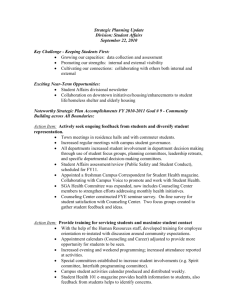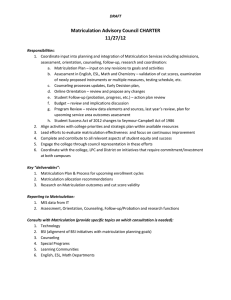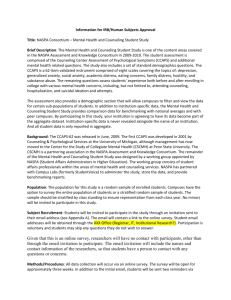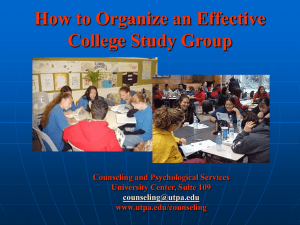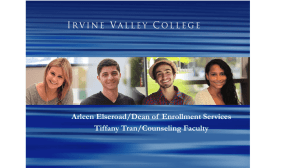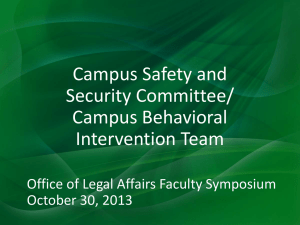Creating a Sustainable and Collaborative
advertisement
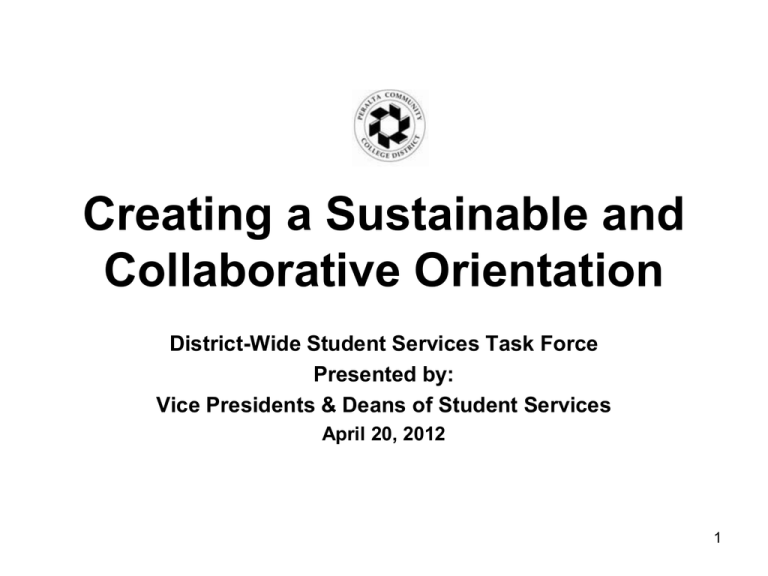
Creating a Sustainable and Collaborative Orientation District-Wide Student Services Task Force Presented by: Vice Presidents & Deans of Student Services April 20, 2012 1 Mission Statement: Creating a Community of Success Student Engagement Academic Skills and College Readiness Instruction Learning Community Education & Career Goals Course Alignment Support Faculty, Staff, Students and External Community Support Services, extra-curricular activities, clubs & organizations 2 Retention Factors • Retention is multi-variant and single causal factors are difficult to ascertain. • Persistence depends on the extent to which an individual has been integrated into the academic and non-academic components of the campus environment (student engagement). • Students do not come to college with a cognitive map of functioning and 3 prospering. Promising Practices in Student Success Planning for success: Assessment & Placement Orientation Goal setting & planning Initiating success: Accelerated Developmental Education First Year Experience Student Success Course Learning community 4 Promising Practices in Student Success Sustaining success Class Attendance Early alert & Intervention Experiential Learning Tutoring Supplemental Instruction 5 Elements of Successful Orientation (Learning Assistance Programs) Demystify the college experience Decode the environment Demystify Decode Diagnose Diagnose individual readiness Develop Develop academic preparedness 6 Orientation Objectives Introduce the college community to new students from both an academic and personal perspective Provide information and assistance to new students so that they may succeed academically and develop personally Ensure that students feel adequately prepared to face the challenges of their first year Allow students to meet each other and develop new relationships 7 Orientation Objectives Provide peer counselors who can share their own experiences as a source of support and information Expose students to the wide range of issues facing them as PCCD students, including factors affecting their personal health & safety Introduce the variety of students services that are available on campus, so that students feel able to navigate the college on their own as they transition into their second year 8 Re-framing Orientation – Learning Assistance Orientation is an on-going process that is designed to providing students the right information at the right time. It is not a static event but an evolving and holistic process of educational development. Orientation requires the intelligent leveraging of resources both human and fiscal. Orientation is collaborative learning process – student/faculty; staff/faculty and, staff/student. 9 Orientation as a Continuum Core Elements Career Courses and Learning Communities Orientation, Assessment and Counseling Student Success Courses & FYE 10 Orientation Manifesto Orientation and matriculation must be mandatory Collaboration between instruction and student services is essential Elimination of obstacles that deter students from being successful Be prescriptive: Intervene early and often (engage) 11 Student Support Manifesto Sustained: Lasting throughout a student’s college career Intrusive: Mandatory & structured so students must participate at regular intervals Integrated: Multiple forms of support are offered and silos broken down Personalized: Students receive the type of support they need from someone who knows them well Proposal: Two Part Orientation 1. Intensive: One to two day Orientation (occurring prior to the beginning of the semester and prior to counseling and enrollment into classes). 2. Continuous: One or two semester – First Year Experience 13 Intensive One to Two Day Orientation Model: • Presentations – General overview, interactive, student panels, mock classes • Specialized program orientations • Campus Tours • Centralized Advising, Course Scheduling and Enrollment. • Financial Aid Support Workshops • SLO Assessment • Success Checklist 14 Team Presentations • • • • • • • • • • • • • • EOPS/CARE Financial Aid DSPS Counseling Tutoring Teaching Faculty (CTE and other cohort programs) English Math Library Learning Communities Career Center Health Center Student Panel/Clubs and Organizations/Leadership Veterans 15 Process Flow Orientation Assessment Counseling 16 New Orientation Model: Continuous Year Long: • College Success Course • First Year Experience Program (cohort) • Contextualized and/or Accelerated Instruction • Career Development Course • Learning Community • End-of-year Orientation • Student Educational Plan 17 First Semester Orientation Assessment Advisement/Course Selection College Success 101A First Year or Reentry Course SEP 18 Second Semester Advisement/Course Selection Career Development Learning Community College Success 101B Orientation SEP 19 Program Elements Mandatory for all new students New students could not enroll prior to intensive orientation New students could not enroll late Program begins 2013 New students have priority enrollment for the second semester 20 Online Orientation* • • • • • • Welcome Success Tips Every section has a test Final test at end of orientation 45 minutes Results will be submitted and included in matriculation process • SEP SLO for Online Orientation Student Learning Outcomes 1) 1) 1) Students will be able to identify the matriculation process at Merritt College Students will have information to Merritt College services that will support their educational and personal goals, e.g. libraries, information technology, academic, counseling and student services departments Students will have an appointment or have signed up for their Math /English assessment (as a measure of current skill levels in reading, writing, and mathematics) Assessment Methods When will you collect this information? Student will complete online orientation quiz Student will complete online orientation quiz After the completion of online orientation quiz, (possible cut score) Student will complete online orientation quiz After the completion of online quiz, link to assessment appointment page OR printout of assessment schedule After the completion of online orientation quiz, online certificate 22 Implementation Timeline Stakeholder consultation and campus planning teams to develop detailed plans now Peralta teams communicate with feeder high schools, and other local community agencies/organizations beginning in fall of 2012 to describe the program. Begin Spring 2013 as a pilot Full implementation – Fall 2013 23 Issues to Address • Definition of new and/or matriculating students • On-line orientation implementation • Involve students in planning and develop student peer advising component. • Clarifying the scope of "First Year Experience“, and Learning Communities within the framework of Orientation. 24 Shared Governance Stakeholders that need to be involved in planning: • District and college matriculation committees • District and college academic senates • VP/Deans of Instruction and Student Services • IT (mandatory holds, etc.) • Admissions & Records • College Counseling and Teaching faculty and classified staff • Assessment staff • District and college marketing staff 25 Questions? 26
